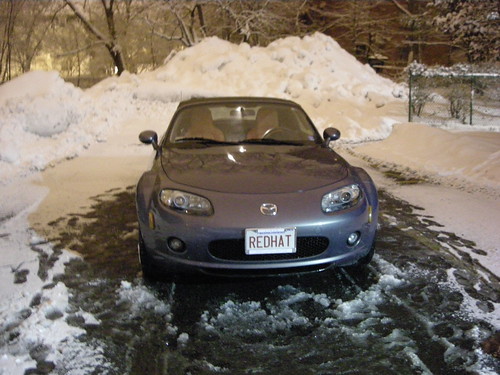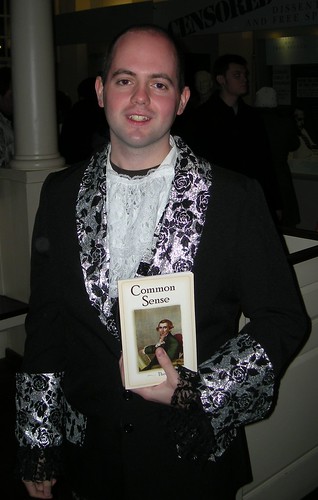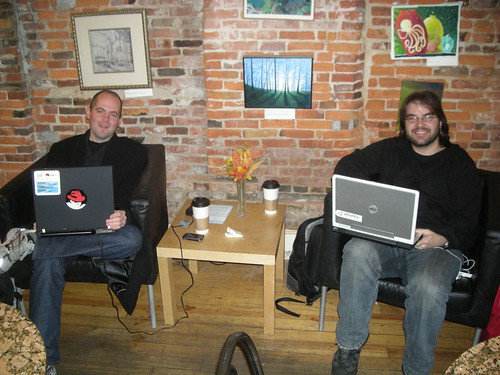So I’m overdue for a random blog posting, in case anyone cares about what’s going on in my life. Read on for a summary of my latest visitors’ trips, what I did over Thanksgiving, whether I’m still heartbroken, and other stuff.
The past month has seen various visitors to these parts. Mostly European in nature (and with the anniversary of the Boston Tea Party coming up on the 16th of next month, who can blame them?), and all very welcome to stay here any time. First up, there was Paul (Sladen), who randomly turned up in his customary fashion, in need of a place to crash. Paul, you’re the nicest guy in the world, but there’s a reason we don’t tell you where we live these days, and of course, you know where I am now 
Paul enjoyed my “wanker car” (the doctored photos he’s published in which my exhausts are twice the size, I’m parked in a disabled bay, and the plate reads “WANKER”, instead of my usual vanity plate, demonstrate a hidden artistic talent seeking an outlet – you’re still missing an oversized Star Spangled Banner on my antenna, though, dude), and I drove randomly to the beach one night at around midnight with him in the car, stopping to get Dunkin Donuts on the way. Not that I eat any of that stuff now, and I’m long since not the “fat bastard” I might have been labeled in the past. Paul’s playing catch up on that front, especially with all of those American deserts.

Photo: Jonathan Riddell, in my “wanker car”.
Jonathan Riddell was my next visitor. We caught up on life, the universe, and other stuff, wondered around town (and actually managed to get lost briefly somewhere on Beacon Hill), went shopping for PC stuff at prices insanely lower than anyone visiting from the UK will be accustomed to, and took some random drives around the local region for good measure. I also serve as a convenient taxi service to visiting hackers en route to Logan – not that I noticed him leaving behind his executive washroom Canonical-have-free-airport-lounge-use card for me to look after. Maybe it’s hiding somewhere on my couch though.

Photo: Jon Masters and Dan, at Harvard University.

Photo: Dan, at the USS Constitution
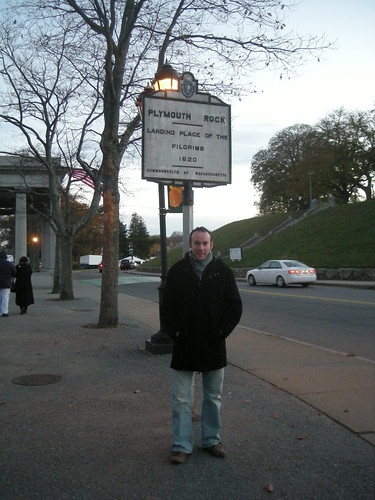
Photo: Dan, in Plymouth
To top off the triple visits in a month, my friend and old college buddy Dan came to visit for 10 days too. We did the typical touristy experiment, along the same lines as the trip my Dad and Gran had made previously, but with some twists. For example, we probably did a fair bit more drinking than I seem to recall doing with my Gran  Let’s see…Dan got in on the Thursday night before Thanksgiving. We did a bunch of local things (went to see the USS Constitution, Bunker Hill, Faneuil Hall, The Mayflower II replica in Plymouth – the staff there recognize me now, Sunset Bar and Grille, various random movies), but then I took the day before Thanksgiving off so we could head down to NYC. We’d planned on going down to D.C. too, but neither of us really felt like it, and both of us had colds by then. It didn’t really matter though, because there wouldn’t really have been time. I *need* to go down to see the Declaration of Independence soon anyway.
Let’s see…Dan got in on the Thursday night before Thanksgiving. We did a bunch of local things (went to see the USS Constitution, Bunker Hill, Faneuil Hall, The Mayflower II replica in Plymouth – the staff there recognize me now, Sunset Bar and Grille, various random movies), but then I took the day before Thanksgiving off so we could head down to NYC. We’d planned on going down to D.C. too, but neither of us really felt like it, and both of us had colds by then. It didn’t really matter though, because there wouldn’t really have been time. I *need* to go down to see the Declaration of Independence soon anyway.
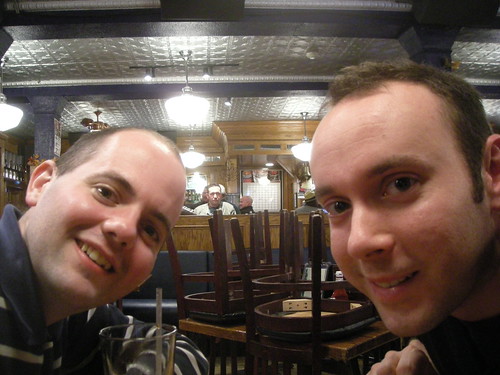
Photo: Jon Masters and Dan, in Connecticut
We drove down to Connecticut on Tuesday night. Yes, I do mean Stamford, but this was purely for logistical purposes – it’s easy to get to NYC on the MTA, it’s the first stop on the express train, etc. (we carefully avoided going anywhere my ex-girlfriend was likely to be, so as to not bother her over Thanksgiving). Stayed there Tuesday and Wednesday nights, taking the train into New York Wednesday and Thursday, and caught the tail end of the Parade. Dan enjoyed being in New York again – it’s changed a bit since last century. Heck, I missed New York, and it’s only been a few weeks since I was last down there. I suppose I should go down more often when I need to cheer myself up with culture – Boston is wonderfully civilized, but lacks some things found only in NYC.

Photo: A view of downtown Manhattan, from the Empire State Building.
I usually avoid going to Ground Zero. It upsets me deeply to think of this country being hurt like that (that was one of the reasons I finally decided I must move here, and I was standing at ground zero at the time I made that decision too). And every time I go down there I feel strangely moved. I don’t take photos of ground zero itself – I find it abhorrent that tourists do this, especially the happy smiley photos – but I did, after some consideration, finally take a photo with the WTC site in the distance, for a contrasting view of the urban lower Manhattan landscape. We went and took some photos of the NYSE, Wall St., and other such things. I missed out on going to Central Park, but I’ll need to head down before the New Year anyway, so I can go ice skating properly.

Photo: Macy’s Thanksgiving Day Parade, 2007.
We ate at Roxy’s, Ruby Tuesday, and any other places I thought Dan should “experience” while in the States, and specifically, while we were down in New York. We took a stroll along Battary Park, and I suggested a detour over to Jersey, for the view. We were just outside the Wiley offices (one of my publishers), which really do have a lovely view of Manhattan from across the Hudson. Driving wasn’t as painful as I had anticipated that it would be over the holidays – we likely had more traffic on Black Friday, when we went down to the Premium Outlets. I shop in Banana Republic a bit too much, it would seem, since the staff recognize me. A side-effect of having to change my wardrobe so many times this year. I can do fashion. I bought some shoes in Clarks. Amusing.

Photo: An MBTA red-line “T” train crossing the River Charles from Cambridge into Boston.
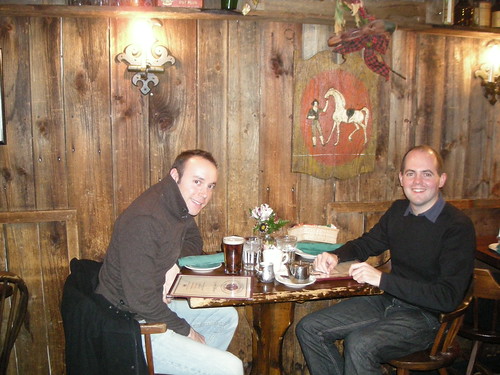
Photo: Dan and Jon Masters, at the Old Colonial Inn, in Concord, having afternoon tea.
Dan flew out on Saturday, after we made one final trip, to Concord, for tea at the Old Colonial Inn, and to see the Old North Bridge. I’ve been there many many times by now, and Concord is always somewhere I like to show British visitors – it’s very peaceful and quaint, and historically important. Besides, there are some great little coffee shops and the food at the ‘Inn can’t really be beaten. I hope to spend some quality time up there over the winter with a warm drink, and one of the many books I’m reading at the moment on US history, legal history, and just anything to do with that Revolutionary Period in general. On a side note, my latest test machines in the office – theterrible, and kingofprussia, are continuing my naming convention of using ships Thomas Paine sailed on. My desktop is called LondonPacket, the name of the ship he finally emigrated in.
I’m a size small. Finally. I’m not the extra large person you might remember, if you haven’t seen me recently. I’m around 160lbs now, a size small, and could actually fit into a pair of 29″ jeans, if Banana actually stocked those in store. I don’t plan on withering away, so I won’t go down much more, but I am likely to hit 150lbs if I possibly can manage it. I call that a positive side effect of being semi-permanently broken hearted, which I finally gave in and admitted to feeling. I’ve tried dating other girls this year, and had recently met a very interesting lawyer too, but I have now finally realized that I’m just not over Ms. K. I have no idea how long it’ll take to get over her, or if it’s actually going to even be possible, but at least I accept it now. And that’s strangely calming too.
This year has been punctuated with absolute craziness. I think I’ll try calming down a little over the Christmas break, well, maybe. I’ve decided to spend Christmas largely miserable and alone, but it’s something I need to do. I might well end up in Woodstock, Vermont at this rate (I was there last year, but those were happier times), just to upset myself some more, but sometimes it’s good to be in touch with one’s emotions. There’s no need to try to cheer me up, because you can’t. I’m not depressed – depression is unexplained unhappiness, whereas I know precisely why I feel sad, lonely, and upset. She meant the world to me, still does, and I don’t mind accepting that finally.
Jon.
